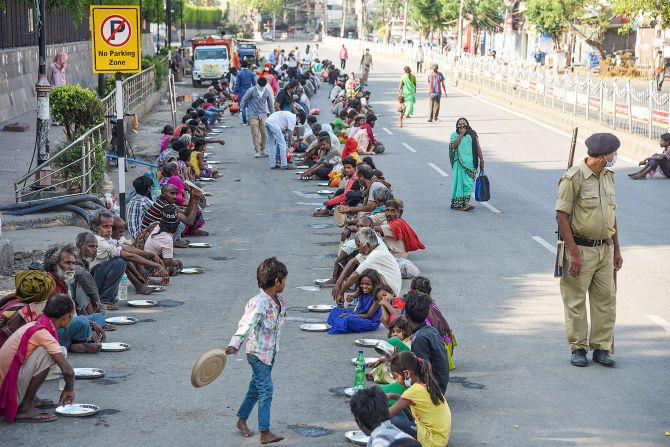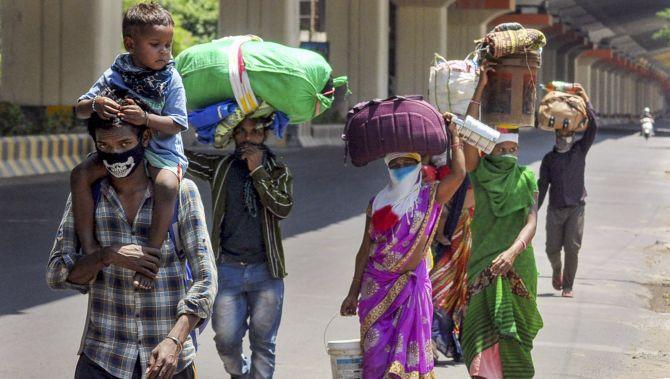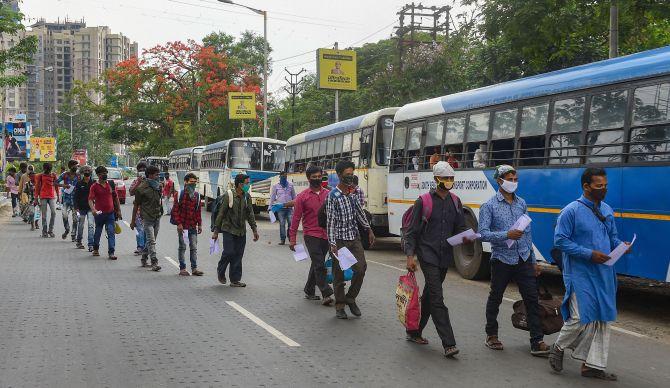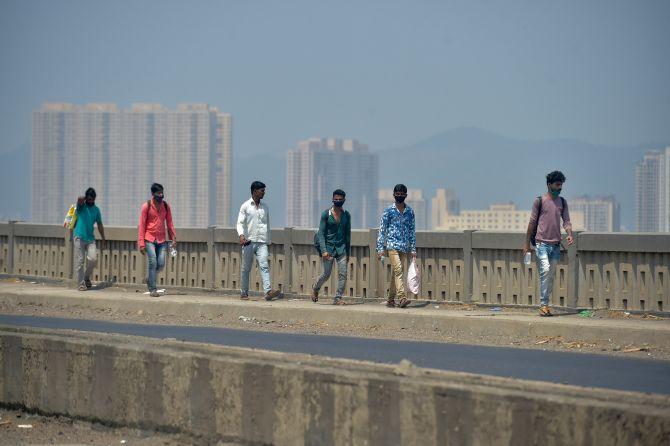 | « Back to article | Print this article |
'We need to have the courage to take a rational look at known facts and act accordingly,' advises Mohan Guruswamy.

It is time now to sit back and objectively reconsider the draconian policy measures unleashed in India.
In one fell stroke we have managed to render wageless at least 100 million people.
We still don't have any record of deaths due to lockdown stress, but we are getting a clearer picture of economic losses.
Epidemiological studies put out at several well regarded institutions such as MIT and the Global Virus Network suggest that this particular coronavirus is endemic in populated areas falling in temperature band of 3-17C with a humidity between 51 to 79%.
These initial findings suggesting a correlation between latitude and incidence have the powerful endorsement of Dr Robert Gallo, the famed virologist and head of the Global Virus Network.
The essential facts about COVID-19 is that while it is virulent, its fatality is about 3% and this is principally concentrated among the elderly and already ailing.
Its symptoms are mostly akin to common seasonal flus often attributed to change of season etc.
Over 80% of the infected remain asymptomatic or have mild symptoms.
COVID-19 can only be confirmed by testing and the cheapest test costs about Rs 4,500 each.
What we are testing only confirms this. There is no treatment and no vaccine, as yet. We must focus on that.

The average life expectancy of Indians is 68.7 years.
The above 65 years cohort accounts for only about 6% of India, which suggests that the incidence of fatality here will be lower.
Bubonic plague has a mortality of over 80%, while even diphtheria has a mortality rate of almost 20%.
COVID-19 is not a killer virus. In the developed countries like the USA, Italy and elsewhere with substantially higher life expectancy, the 70+ years cohorts are much bigger.
The mortality rate due has been the highest in Italy with about 9%.
Almost 86% of the Italians who died were over 70 years. Italy has the second oldest population in the world after Japan, with over 23% over 65 years.
Experts believe this was the determining factor in its high fatality rate.

The goal of social distancing is a hugely unfulfilled aspiration.
The poor in India live cheek by jowl, with densities often exceeding 60,000 per sq mile.
India has over 410 million workers in the unorganised sector, the vast majority of whom are daily wagers making a little more than the prescribed official wages and often much below that.
This working age cohort is mostly made up of younger Indians. The youthful age group (14 to 35 years) accounts for about 34% of India's population.
This cohort is about as much as the 35 to 65 years cohorts. Thus, even if the pandemic is real for India, the fatality due to it will be very low.
The vast majority of Indians who might get infected by COVID-19 virus won't even know it.
Now assume that the COVID-19 pandemic will overwhelm India, and consider India's abysmal health care scene.
We have 6 physicians, 9 hospital beds and 13 nurses per 10,000 people.
Nationwide, we have less than 40,000 ventilators and only 70,000 intensive care beds.
This calls for a policy that will help stagger the load and allow immunity to build up without overwhelming the critical care system.

Harvard's Yonatan Grad, professor of immunology and infectious diseases, and colleagues conducted research on how to prevent overwhelming the US health care system during the pandemic.
This indicates the only possible method for dealing with the epidemic may be multiple 'intermittent' social distancing periods that ease up when cases fall to a certain level and then are re-imposed when they rise past a key threshold.
As time passes and more of the population gains immunity, they said, the restrictive episodes could be shorter, with longer intervals between them.
Clearly, the nationwide simultaneous social distancing imposition was not only, but also ill conceived.
Dr Johanne Giesecke, one of the world's most senior epidemiologists, advisor to the Swedish government, the first chief scientist of the European Centre for Disease Prevention and Control, and an advisor to the director-general of the WHO, lays out with typically Swedish bluntness what he thinks:

Closer home, Dr Jayaprakash Muliyil, former dean of the Christian Medical College and Hospital, Vellore, is also unequivocal about the efficacy of lockdown.
He says we must build herd immunity while shielding the vulnerable.
Dr Muliyil also made clear that the flattening of the incidence curve would stop once the lockdown is lifted.
The lockdown cannot be a permanent solution.
'The question of containing the virus is out. In 2009, there was an epidemic of H1N1 influenza. What happened to it? It came in and stayed for 2-3 months and spontaneously disappeared. Nothing that we did at the point of time was of help. It went away. Why?,' says Dr Muliyil.
'It is because of a certain level of herd immunity that was produced by the infection. So, our only hope is that, on its own, this virus is headed line in that way -- in a particular way of herd immunity,' Dr Muliyil adds.
Apart from the coronavirus pandemic, we seem to be also afflicted by a panic and hysteria pandemic.
We have begun to fear the worst is at hand. Far from it. This is not bubonic plague or small pox.
This is a more inspired version of the seasonal flus we have been accustomed to but with a slightly higher case fatality rate.
We need to have the courage to take a rational look at known facts and act accordingly.
We must lockout our fears and ease off the lockdown.